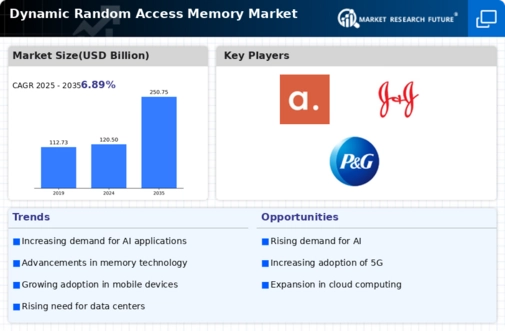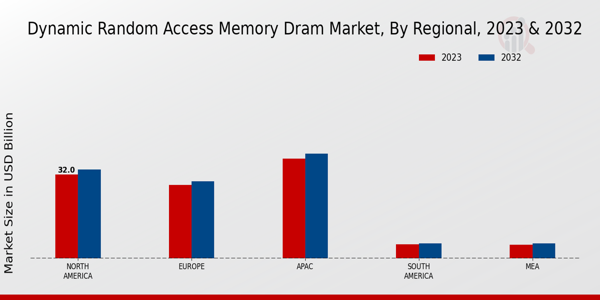Market Growth Projections
The Global Dynamic Random Access Memory Market Industry is projected to experience substantial growth, with estimates indicating a market value of 120.5 USD Billion in 2024 and a remarkable increase to 250.75 USD Billion by 2035. This growth trajectory suggests a compound annual growth rate (CAGR) of 6.89% from 2025 to 2035, reflecting the increasing reliance on DRAM in various applications. The market dynamics are influenced by factors such as technological advancements, rising consumer demand, and the proliferation of data-intensive applications, which collectively drive the need for innovative memory solutions.
Emergence of 5G Technology
The Global Dynamic Random Access Memory Market Industry is significantly impacted by the emergence of 5G technology, which promises to revolutionize connectivity and data transmission. The rollout of 5G networks necessitates enhanced memory capabilities to support the increased data traffic and faster processing speeds. As telecommunications companies invest in infrastructure to accommodate 5G, the demand for DRAM is expected to rise correspondingly. This technological shift not only enhances mobile communication but also drives the need for high-performance memory solutions in various applications, including IoT devices and smart cities.
Advancements in Cloud Computing
The Global Dynamic Random Access Memory Market Industry is significantly influenced by the rapid advancements in cloud computing technologies. As businesses increasingly migrate to cloud-based solutions, the demand for high-capacity and high-speed memory solutions escalates. This transition is expected to contribute to the market's growth, with projections indicating a market size of 250.75 USD Billion by 2035. The need for efficient data processing and storage in cloud environments underscores the importance of DRAM, as it plays a critical role in ensuring optimal performance and reliability for cloud services.
Increased Investment in Data Centers
The Global Dynamic Random Access Memory Market Industry benefits from increased investments in data centers, which are essential for supporting the growing demand for digital services. As organizations expand their data storage and processing capabilities, the need for efficient and high-capacity DRAM becomes paramount. This trend is likely to contribute to the market's growth, as data centers require advanced memory solutions to handle vast amounts of information. The ongoing digital transformation across industries further amplifies this demand, positioning DRAM as a critical component in the infrastructure of modern data centers.
Rising Demand for Consumer Electronics
The Global Dynamic Random Access Memory Market Industry experiences a surge in demand driven by the proliferation of consumer electronics such as smartphones, tablets, and laptops. As of 2024, the market is valued at approximately 120.5 USD Billion, reflecting the increasing reliance on high-performance memory solutions for enhanced user experiences. The trend towards more sophisticated applications, including gaming and multimedia, necessitates advanced DRAM technologies. This growing consumer base is likely to propel the industry further, as manufacturers strive to meet the escalating requirements for speed and efficiency in electronic devices.
Growth of Artificial Intelligence Applications
The Global Dynamic Random Access Memory Market Industry is poised for growth due to the expanding applications of artificial intelligence (AI) across various sectors. AI technologies require substantial memory resources to process large datasets and perform complex computations. As organizations increasingly adopt AI solutions, the demand for high-performance DRAM is likely to rise. This trend suggests a robust market trajectory, with a projected CAGR of 6.89% from 2025 to 2035. The integration of AI in industries such as healthcare, finance, and automotive further emphasizes the necessity for advanced memory solutions to support these innovative applications.





